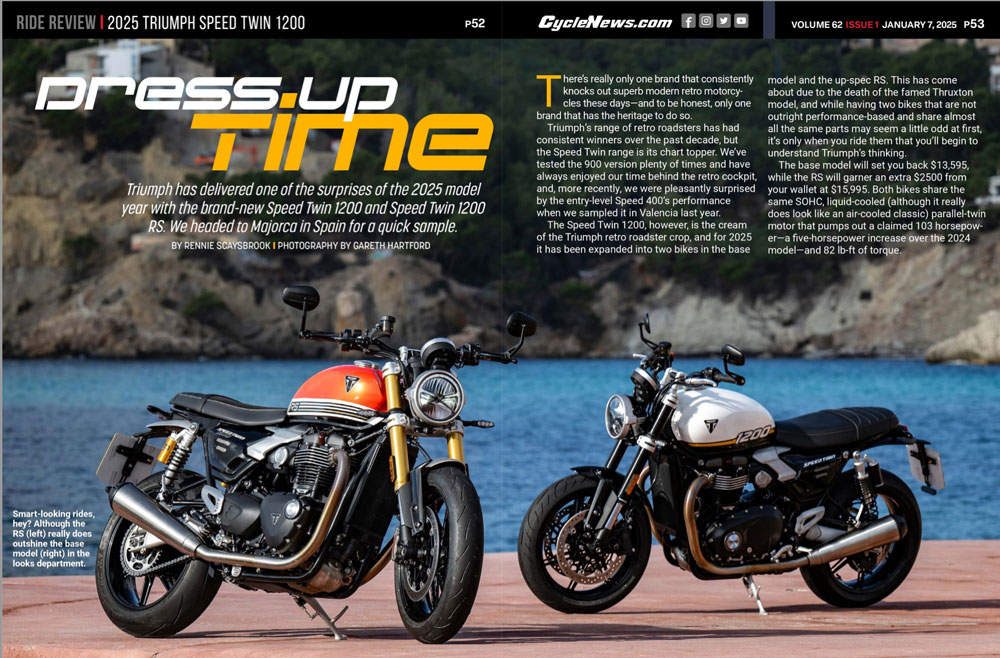Rennie Scaysbrook | January 17, 2025
Triumph has delivered one of the surprises of the 2025 model year with the brand-new Speed Twin 1200 and Speed Twin 1200 RS. We headed to Majorca in Spain for a quick sample.
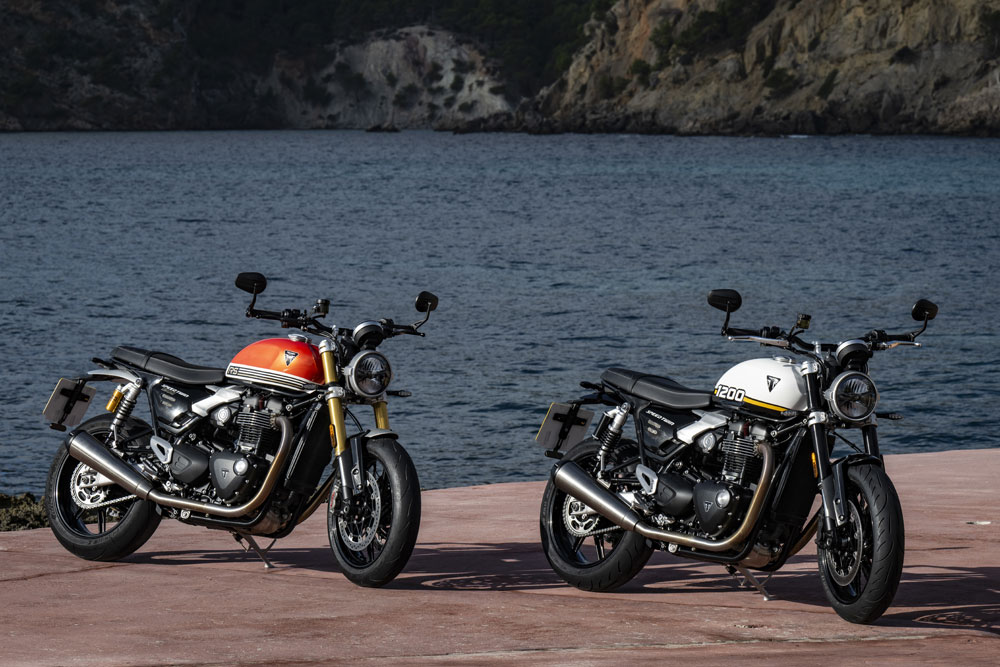 Smart-looking rides, hey? Although the RS (left) really does outshine the base model (right) in the looks department.
Smart-looking rides, hey? Although the RS (left) really does outshine the base model (right) in the looks department.
Photography by Gareth Hartford
There’s really only one brand that consistently knocks out superb modern retro motorcycles these days—and to be honest, only one brand that has the heritage to do so.
Triumph’s range of retro roadsters has been consistent winners over the past decade, but the Speed Twin range has been its chart topper. We’ve tested the 900 version plenty of times and have always enjoyed our time behind the retro cockpit, and, more recently, we were pleasantly surprised by the entry-level Speed 400’s performance when we sampled it in Valencia last year.
The Speed Twin 1200, however, is the cream of the Triumph retro roadster crop, and for 2025 it has been expanded into two bikes in the base model and the up-spec RS. This has come about due to the death of the famed Thruxton model, and while having two bikes that are not outright performance-based and share almost all the same parts may seem a little odd at first, it’s only when you ride them that you’ll begin to understand Triumph’s thinking.
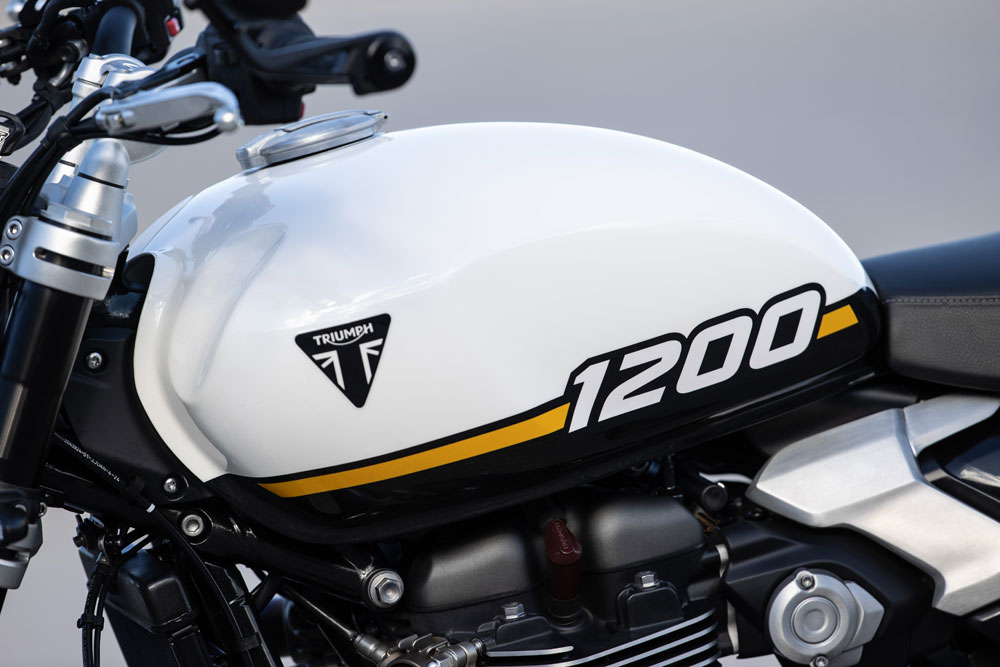 The understated white and pinstripe gold/yellow colorway for the base model retains a touch of class.
The understated white and pinstripe gold/yellow colorway for the base model retains a touch of class.
The base model will set you back $13,595, while the RS will garner an extra $2500 from your wallet at $15,995. Both bikes share the same SOHC, liquid-cooled (although it really does look like an air-cooled classic) parallel-twin motor that pumps out a claimed 103 horsepower—a five-horsepower increase over the 2024 model—and 82 lb-ft of torque.
Both bikes run the same tubular steel cradle chassis, the same 476 pounds, and the same single-dial cockpit, replacing the old model’s twin analog tach. This is the first time the Speed Twin 1200 has come with lean angle-sensitive traction control and ABS, although the former is only an on/off option regardless of throttle modes, while you can’t turn ABS off at all.
There are other cosmetic nips and tucks, including a new headlight and a new one-piece TFT dash you can pair your phone to.
But that’s essentially where the similarities end.
 The Baja Orange colorway looks something straight out of a café racer film.
The Baja Orange colorway looks something straight out of a café racer film.
The base model runs non-adjustable 43mm Marzocchi forks and preload-only adjustable twin Marzocchi shocks, Triumph-branded four-piston calipers, the show rolls on Metzeler M9 RR rubber, and the seat height is 0.2 in. lower at 31.7 in. compared to the RS’s 31.9 in.
Switching up a few gears, the more expensive and very handsome RS in its Baja Orange colorway runs fully adjustable 43mm Marzocchi forks and brings the bling with Ohlins twin shocks, also fully adjustable.
Braking comes in the form of Brembo’s Stylema four-piston calipers and a span and ratio-adjustable master cylinder, Metzeler’s RaceTec RR K3 rubber adorns the wheels, and the RS gets an extra mode in the electronics in Sport mode compared to the base model’s Road and Wet modes.
The RS also gets an up-and-down quickshifter, and the riding position is substantially altered with lower-set handlebars and footpegs that are set higher and further back to get more weight over the front end and help that track-specific Metzeler rubber dig into the ground.
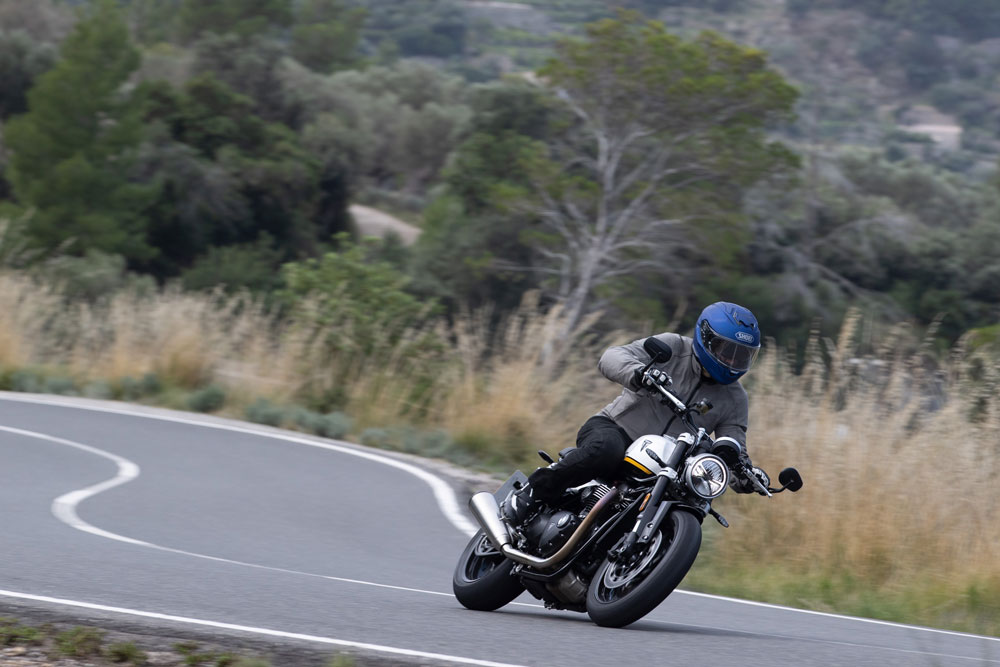 Nimble on its feet to a point, the base model will be plenty fine for the rider who doesn’t need an extra performance edge.
Nimble on its feet to a point, the base model will be plenty fine for the rider who doesn’t need an extra performance edge.
2025 Triumph Speed Twin 1200 Base Model Ride
You could almost feel sorry for the base model Speed Twin 1200 when sitting next to its blinged-up brother in the RS. The base model’s white and gold pinstripe package looks almost subdued compared to the eye-popping RS’s Baja Orange, but if you expect the ride to be any less lively, you’re thankfully mistaken.
Our test in Majorca had us out on the base model early, and if you’d left me on that for the day, I’d have been quite happy. Understated it may be, the base 1200 is still a thoroughly handsome machine with ultra-clean lines and very little clutter. The shiny twin pipes are pure Triumph in their design and, believe it or not, do indeed house catalytic converters, which just goes to show how poor some manufacturers’ attempts at hiding cat converters really are.
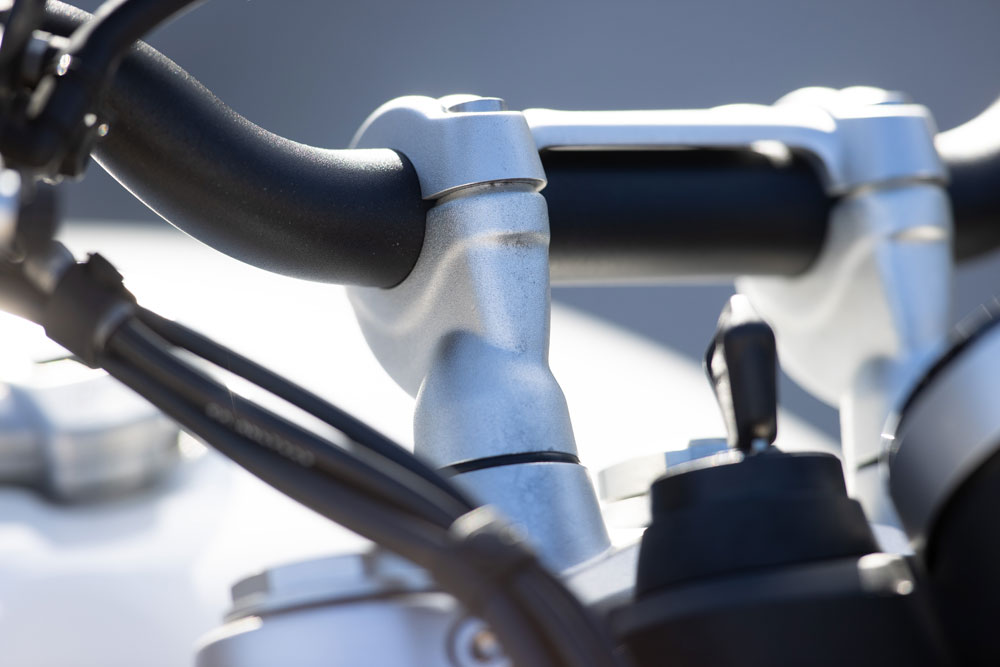 Higher-set handlebars on the base model make for a slightly more comfortable ride than on the RS.
Higher-set handlebars on the base model make for a slightly more comfortable ride than on the RS.
The base model is more akin to the old roadsters that inspired these machines than the RS is, which almost has a supersport complex to its personality. With a slightly higher set handlebar and lower set footpegs, the ride is relaxed and cruisy on the base model. Due to near spot-on fueling, the low-speed manners of the 1200 are impeccable as we negotiated the early morning Majorcan traffic. There’s no quickshifter on the base model, but that matters hardly anything, as the short throw and tight gearbox give lovely, fast gear changes as you click a gear higher and keep the motor singing between 4-6000 rpm. Short shifting is the name of the game with the Speed Twin, with lots of unrelenting drive matched to that trademark Triumph flat drone exhaust note.
Get the 1200 singing above this mark, however, and there’s still plenty of performance to be had from the SOHC parallel-twin, but when speed really begins to increase, that’s when you’ll find the limits of two separate systems—one electronic and one mechanical.
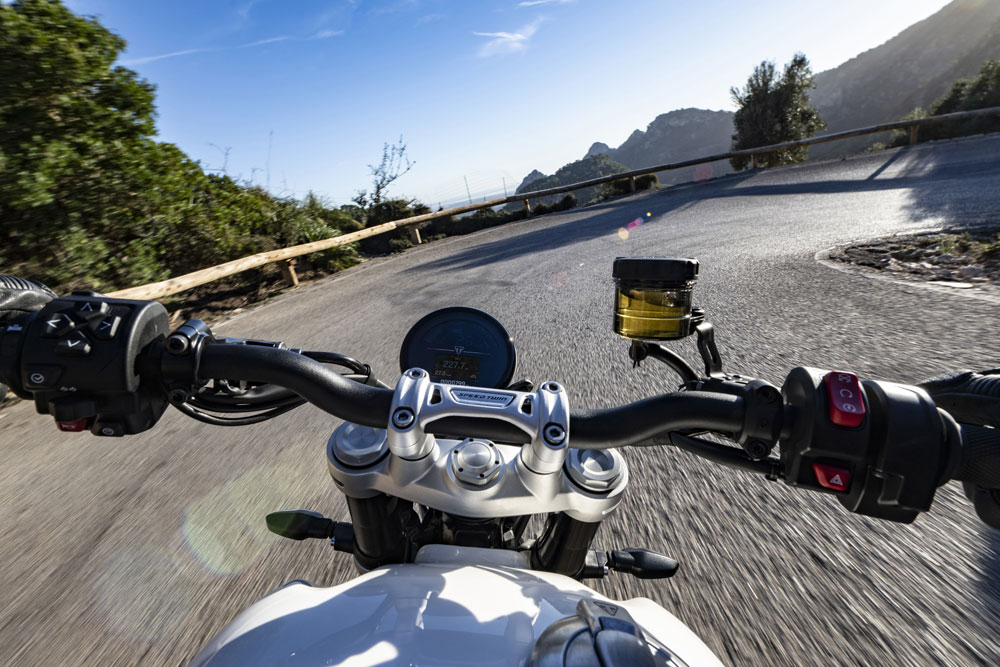 The uncluttered view from the base model’s cockpit.
The uncluttered view from the base model’s cockpit.
Focusing on the latter, the lower-spec Marzocchi fork will begin to reach the end of its performance threshold rather quickly, as do the brakes. Keep the speed to a reasonable pace in which braking is more of a graceful act than a forceful input like it can be on the RS, and the 1200 will oblige. However, hard braking sees the fork push through the stroke a little too fast for ultra-sporty riding, and it’s something that can’t be adjusted, which is a bit of a black spot for a bike costing north of $13K.
Likewise, the Triumph-branded four-piston brakes work just fine at lower speeds but require a decent handful at higher speeds, which can see the ABS kicking in a little too early for my liking.
Another curious trait I noticed was the traction control on the base 1200. As this model doesn’t come with the Sport mode, when the pace heated up, the TC would kick in too early, the telltale orange light on the dash flickering far before I could tell there to be any loss of grip from the rear Metzeler. This, in turn, slowed drive until the 1200 was near upright, meaning you’d get quite a dead spot at the twistgrip right at the time you didn’t want it.
Aside from those gripes, the base 1200 will do fine if you’re after a classy-looking roadster that doesn’t require hard rides up your favorite canyon road. For that sort of carrying-on, you need the RS.
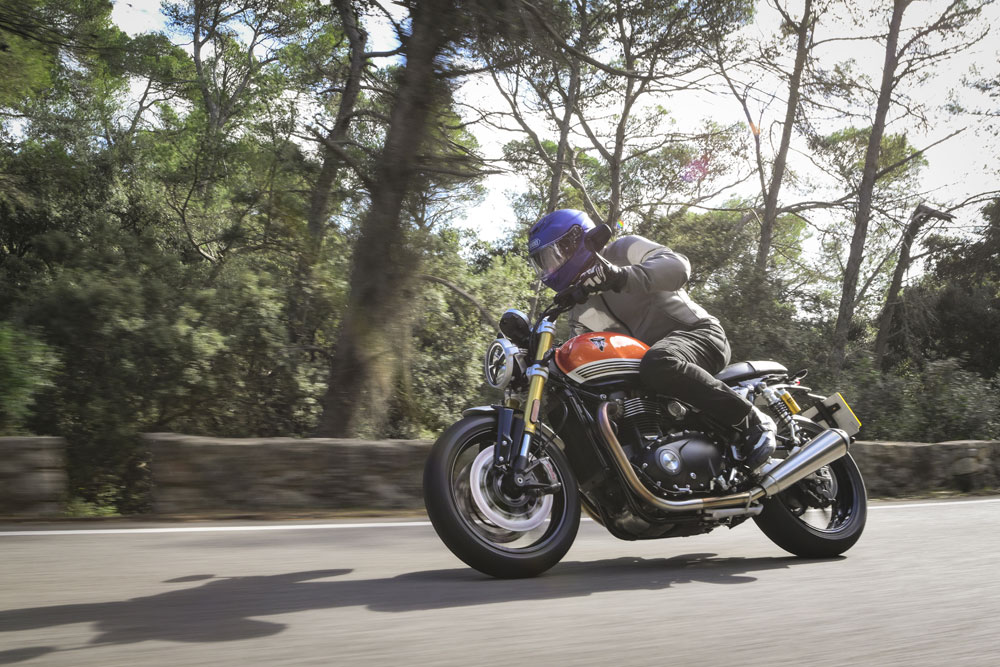
2025 Triumph Speed Twin 1200 RS Model Ride
Switching to the RS, you can tell the sporty genes the moment you sit on it. You’re perched in a racier position with more weight on your wrists, and your feet are perched higher up and farther back on the RS, and even without releasing the clutch, it’s easy to feel the extra stiffness of the fully adjustable suspension.
The RS takes everything the base model has and ratchets it up into the reds. Looks-wise, there’s no contest between the two. The RS is positively gleaming in its Baja Orange paint scheme that gets offset beautifully by the gold on the Ohlins shocks and the silver from the Brembo Stylemas. It’s like the base model has a nice, crisp white t-shirt and clean jeans, while the RS is rocking a fitted suit.
The RS’s extra Sport mode in the electronics enables faster acceleration but also a more abrupt throttle response, so around-town cruising is best left to the Road map found on the base model. But when the pace starts to heat up, the RS in Sport mode is what you want to be on. Quicker acceleration is matched to a sublimely smooth quickshifter, one that delivers a satisfying exhaust pop if you time your shifts just right. There’s a slightly higher rev ceiling on the RS, but like the base model, it still prefers to be short-shifted through the gears and kept between 4000-6000 rpm to give optimum drive.
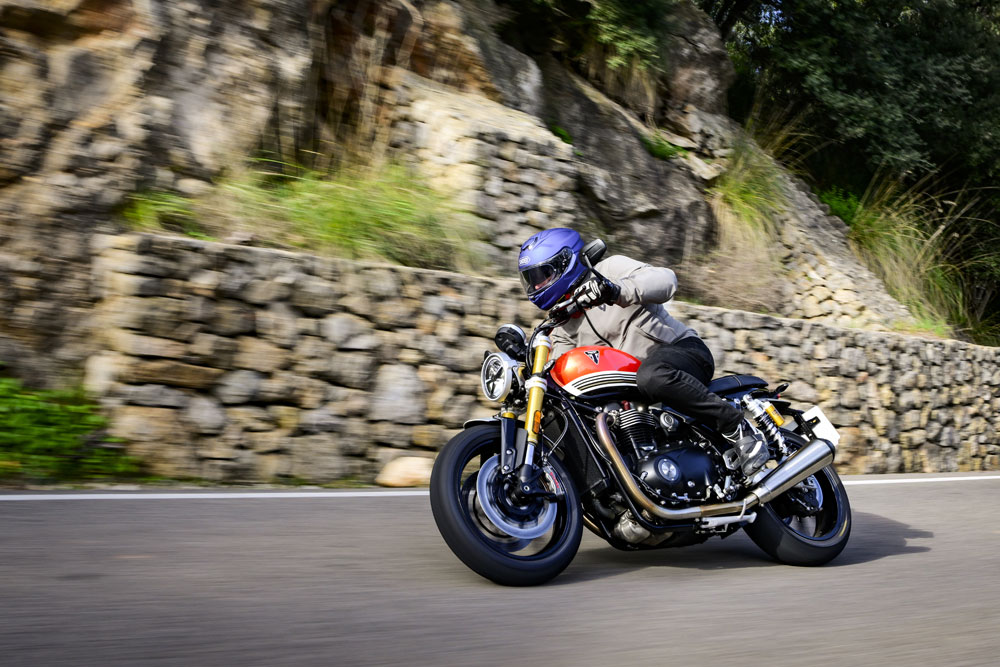 More weight over the front gives the RS some seriously sharp handling.
More weight over the front gives the RS some seriously sharp handling.
Engine-wise, the two bikes may be similar, but the chassis performance between the two is obvious. The racier ride position of the RS allows you to load up the front tire with more weight, letting the Metzeler RaceTek RR K3 rubber bite into the tarmac with more gusto and giving you faster and more direct initial turn speed. A little extra ground clearance given to the RS doesn’t hurt here, either, and you can lean the RS over further without thinking you’re going to grind the pegs off and eventually the tips of your boots.
When it comes to braking, the Brembo Stylema front brake calipers, matched to a higher-spec Brembo master cylinder, are a cut above what you’ll get on the base model. Hard braking from high speed requires two fingers at best, and the more composed front suspension ensures that you won’t get an ABS shudder until it’s absolutely necessary. I’m a massive stickler for master cylinders. To get a good one on your bike costs the manufacturer very little, and it’s an easy thing for them to sneak under the buyer’s radar. Thankfully Triumph hasn’t done this with the RS. What you get is good braking power from the calipers and good feel at the lever from the master cylinder, so thanks, Triumph.
 Ohlins shocks give the RS a competitive edge.
Ohlins shocks give the RS a competitive edge.
Classic Never Goes Out of Style
The older I get, the more I gravitate to these kinds of bikes. At just over 100 horsepower, that’s plenty for my liking and the kind of riding that—if I’m brutally honest with myself—is what I mainly do these days.
However, whether it’s 100 or 200 horsepower, the fact remains that these bikes—be it in base or RS trim (but I’ll take the RS any day)—are very handsome bikes that stand out from the crowd. I’d have liked at least a little adjustability on the front end of the standard bike, but I guess that’s why the RS is there. For the extra $2500, what you get with the RS is well worth the outlay, even if all the general public will see is one has a fancy orange paint job and the other doesn’t.
The best part is these bikes just don’t go out of style. Triumph has done exceptionally well to create an homage to its past while giving you every modern bell and whistle you need, all in a package even my seven-year-old son says is “a good-looking bike.” That’s a pretty big compliment right there. CN
VIDEO | Triumph Speed Twin 1200 – First Ride Review
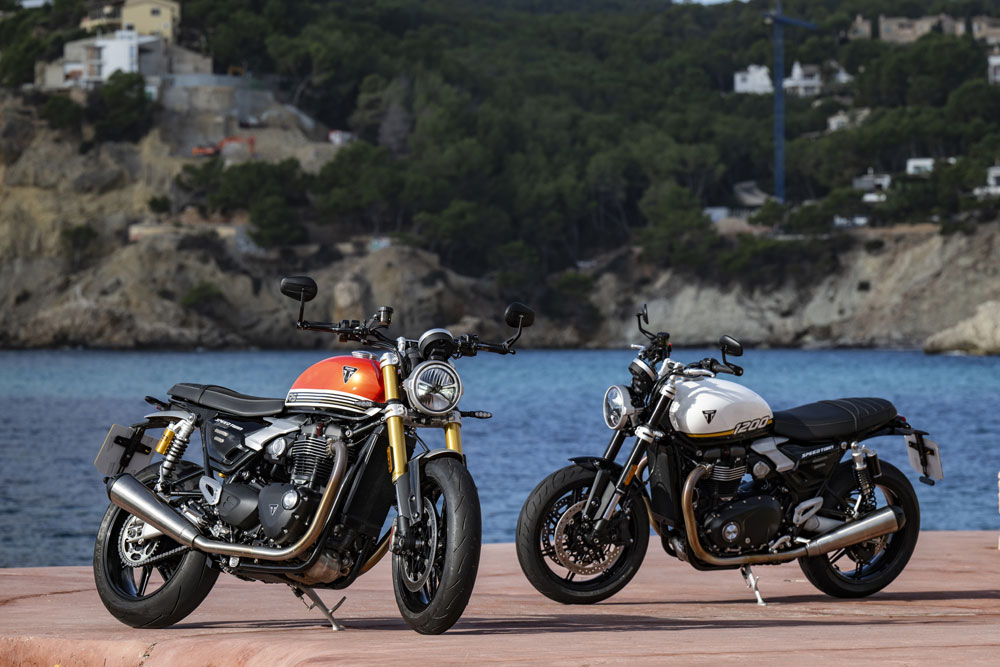
2025 Triumph Speed Twin 1200/Speed Twin 1200 RS Specifications
| MSRP |
$13,595 / $15,995 |
| Engine |
Parallel-twin |
| Valvetrain |
8 valves, SOHC, 270° firing order |
| Cooling System |
Liquid |
| Displacement |
1200cc |
| Bore x Stroke |
97.6 x 80mm |
| Compression Ratio |
12.1:1 |
| Max Power (claimed) |
103.5 hp at 7750 rpm |
| Max Torque (claimed) |
82.6 lb-ft at 4250 rpm |
| Fuel System |
Electronic fuel injection system, ride-by-wire throttle |
| Exhaust |
2-2 |
| Transmission |
Six-speed |
| Electronics |
Two Riding Modes, full LED lighting system, traction control, ABS/Three riding modes, quickshifter, full LED lighting system, traction control, ABS |
| Chassis |
Tubular steel cradle |
| Front Suspension |
43mm inverted Marzocchi, nonadjustable/43mm inverted Marzocchi, fully adjustable |
| Rear Suspension |
Dual Marzocchi shocks, preload adjustable; 4.6 in. travel / Dual Ohlins shocks, fully adjustable |
| Front-Wheel Travel |
4.7 in. |
| Rear-Wheel Travel |
4.8 in. |
| Front Brake |
Dual 4-piston monobloc calipers, 320mm discs, ABS/ Brembo Stylema M4.30 radial-mount calipers, 320mm discs, ABS |
| Rear Brake |
Nissin 2-piston caliper, 220mm disc, ABS |
| Front Tire |
120/70 ZR17 in. |
| Rear Tire |
160/60 ZR17 in. |
| Rake |
22.4° / 22.6° |
| Trail |
3.6 in. |
| Wheelbase |
55.6 in. / 55.7 in. |
| Seat Height |
31.7 in. / 31.9 in. |
| Fuel Capacity |
3.8 gal. |
| Weight (wet, claimed) |
476 lbs. |
